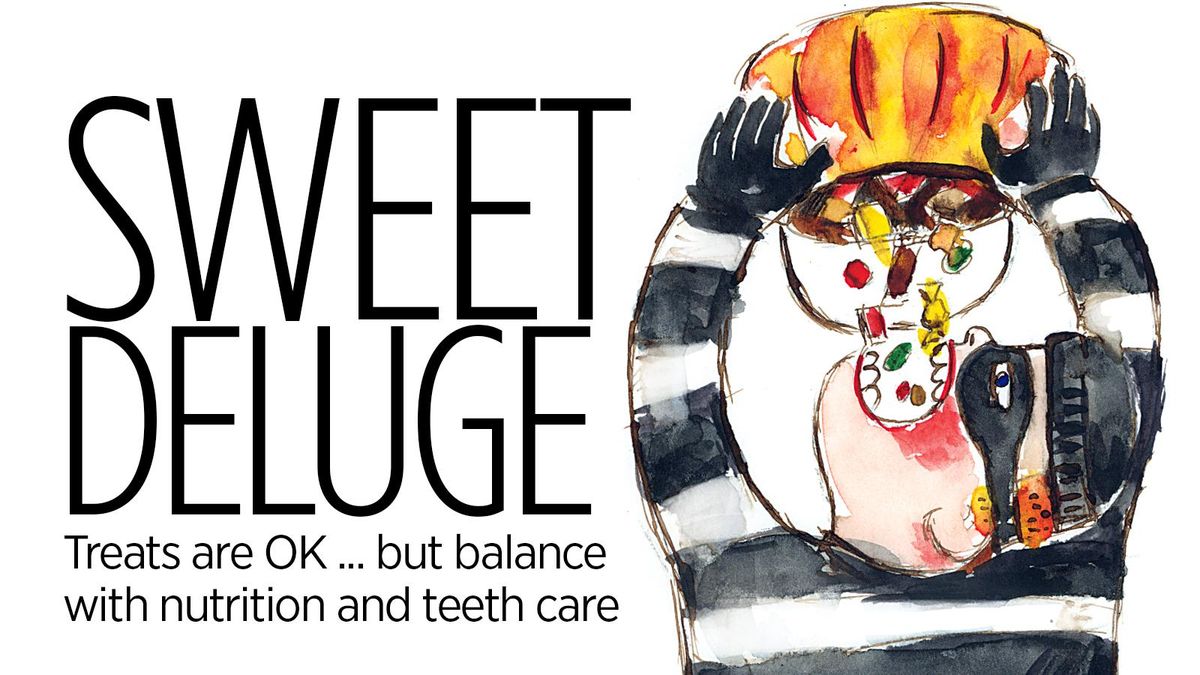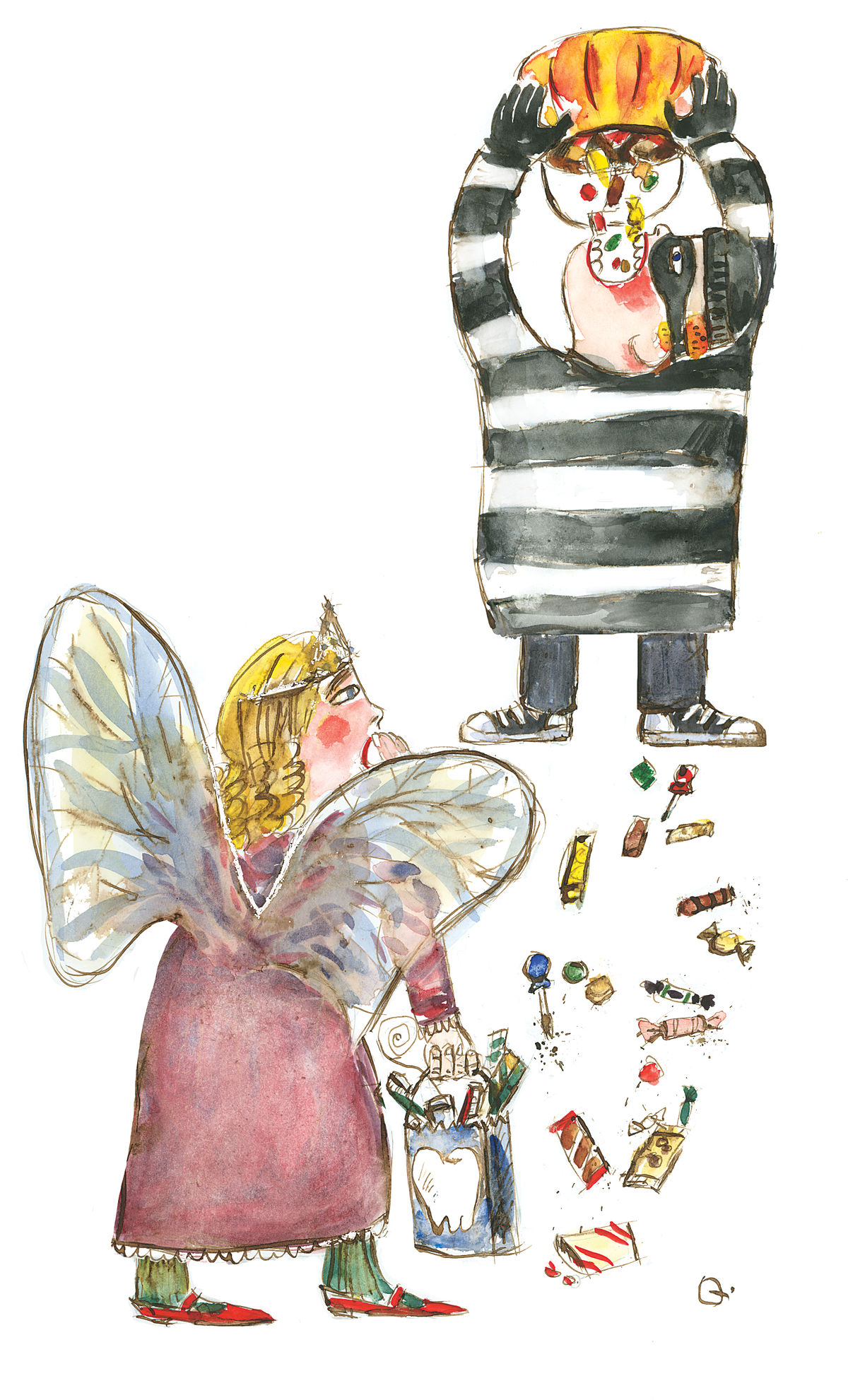Sweet deluge: Treats are OK in candy season if balanced with nutrition, dental care
Halloween kicks off the seasons of sugary temptations.
Between trick-or-treats and Christmas sweets, kids aren’t likely to resist candy and desserts this time of year. But parents can help sweeten the deal around better nutritional choices while also protecting young teeth from sugar overload.
Nutrition and dental experts suggest letting kids have fun, but adults can gently lead toward moderation and timing for when to enjoy sweets. Halloween treats best avoided include hard candies, sugary-sour ones and super-sticky sweets, says Delta Dental of Washington.
“I’m a fan of letting my kids enjoy some Halloween candy, and I don’t want them to be fearful or get negative thoughts about food,” said Monika Jacobson, a Spokane registered dietician and nutritionist who has two preschool-age children.
“We let them eat some Halloween candy after they bring it home, then I like to play games with them, like, ‘We can do some swaps for X pieces of candy, and you can go pick out a toy in the store to buy,’ or we’ll swap it out for something they’re excited about.”
Jacobson stashes away her kids’ Halloween candy to dole out as occasional treats. She also encourages her kids to pick their favorites.
“We’ll let them have one or two pieces a day, so we don’t let them have a free-for-all,” she said. “We tend to give some of the candy away and toss some. I feel like that’s better than all of us just eating it up.”
Alternatives
If pressed to pick out better candy, Jacobson would go for darker chocolate with nuts because of less sugar and some healthy nutrition. Most store-bought candies have loads of sugar, food coloring and preservatives, Jacobson said.
“So much of it has some kind of food coloring and preservatives. It is kind of hard to avoid,” she said. “Aside from trick-or-treating fun, there are ways to make treats using whole foods for Halloween parties or even to be festive with your own family.”
She gave examples of caramel apples with shredded coconut or dried fruits or turning mandarin oranges into jack-o’-lanterns. Other ideas are found online or on Pinterest, she said.
For her nutrition consulting business Eat Move Thrive Spokane, Jacobson recently wrote a blog on holiday fun that isn’t so much about candy.
“At Costco in the Halloween candy section, they have Halloween prizes like mini Play-doh and pencils and stickers.
“Last year during trick-or-treating, someone was handing out plastic vampire teeth, and my kids thought that was the coolest thing of Halloween. There are some fun things that can be handed out that aren’t candy. I’m seeing that more now.”
Navigating sweets
Meanwhile, it might be a good time to ask a family dentist about candy and keeping kids’ teeth in shape. The “pucker” type candies can be most concerning, says a Delta Dental source.
“Sour candy that is sugary and acidic – those are some of the most damaging to teeth because they not only are loaded with sugar to feed bacteria, they’re also highly acidic, so eating those over and over again can contribute to the eroding away of tooth enamel,” said Kyle Dosch, a Spokane-based Delta Dental director and dentist.
Also, the enamel on baby teeth is thinner than on adult teeth, he said, so repeated exposure can be more harmful for younger kids. Parents should consider limiting children’s exposure to acidic treats such as sour gummy worms or mouth-puckering jawbreakers, Dosch added.
If those acidic sour-sweet treats are savored, it’s better for kids to wait 30 minutes before they brush their teeth to give saliva time to work on protecting teeth. Waiting that half an hour also is a good rule after drinking sodas and orange juice that are sugary and acidic drinks.
Saliva in your mouth begins to act as a buffer and brings back a more neutral pH-level in the mouth, but that requires time, Dosch said.
“You need to give your teeth some time to allow your saliva to neutralize that acid in your mouth so your teeth aren’t in a kind of a fragile state where they’re slightly demineralized or the enamel is weakened.
“When the saliva has kind of buffered and re-neutralized your mouth, that is when it’s OK to brush your teeth so you’re not mechanically scraping on your tooth enamel.”
But he said kids and adults should definitely brush their teeth after waiting that half an hour. If you can’t brush, drink water to rinse the mouth.
Here are other tips:
Sticky candies pose a different threat than sour candies because they linger on tooth surfaces and can be more difficult to remove from teeth. This gives bacteria more time to cause tooth decay. Avoid if possible.
Hard candy can take a long time to dissolve in your mouth, and children often end up chewing down on them, an action that risks cracking a tooth. Eat these sparingly followed by a glass of water and brushing your teeth.
Candies with darker chocolate in moderation offer a better choice. Look for a higher percentage of actual chocolate versus milk or sugar, Dosch said.
Sugar-free candy: Delta Dental suggests the best candy choices for kids are options such as sugar-free gum or sugar-free lollipops. These have a sweet taste and encourage saliva production while being less harmful. Dosch said parents also can look for natural sweeteners derived from plants such as Stevia or Xylitol.
Balancing tips
Dosch believes children should be able to enjoy Halloween with candy in moderation. “Candy is so synonymous with Halloween,” he said.
“I think the best advice is just to allow your kids to have that experience while limiting the amount of sweets they’re eating. What’s really important is if your child is going to have candy that it’s not something they snack on throughout the day.”
Try to limit eating candy to once a day during or just after a meal, Dosch added. The worst environment in the mouth is when you eat multiple times in one day with something sugary, he said, because, “You’re bathing your teeth in sugar and lowering the pH in your mouth.”
Overall, Jacobson suggests that it’s important how adults talk about food and candy with children.
“We have to be careful of language, that you don’t demonize the food as something bad,” she said. “Use language like, ‘We get to have a treat, and you get to pick whatever piece you want after you’ve eaten your dinner.’”
“They’ll understand that candy’s not bad; it’s just something we think of as an occasional treat. I think so much is around the language we use as parents and also being an example of that ourselves. I love the idea of having a piece of candy after dinner. Then kids aren’t filled up on candy and are more likely to eat the nutritional dinner.”
Another tip with candy eating is to follow it with a glass of water to help diffuse and wash off some of the sugar on tooth surfaces.
Parents also can consider taking kids to the dentist during the next few months for an additional check on keeping teeth healthy. And ask if your dentist has a candy “buy back” program for Halloween.

